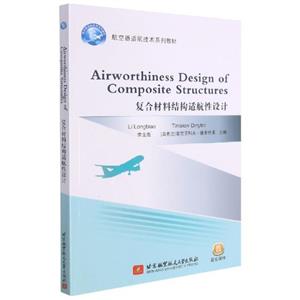扫一扫
关注中图网
官方微博
本类五星书更多>
-
>
湖南省志(1978-2002)?铁路志
-
>
公路车宝典(ZINN的公路车维修与保养秘籍)
-
>
晶体管电路设计(下)
-
>
基于个性化设计策略的智能交通系统关键技术
-
>
德国克虏伯与晚清火:贸易与仿制模式下的技术转移
-
>
花样百出:贵州少数民族图案填色
-
>
识木:全球220种木材图鉴
Airworthiness Design of Composite Structures(复合材料结构适航性设计) 版权信息
- ISBN:9787512435773
- 条形码:9787512435773 ; 978-7-5124-3577-3
- 装帧:一般胶版纸
- 册数:暂无
- 重量:暂无
- 所属分类:>
Airworthiness Design of Composite Structures(复合材料结构适航性设计) 内容简介
本书介绍了民用飞机复合材料结构适航性设计理论与方法,全书共包括7章,分别介绍了适航与合格审定、复合材料的原材料、复合材料的成型工艺与质量控制、复合材料积木式验证方法及应用、复合材料结构疲劳与损伤容限适航符合性验证等内容,是一本集专业性和实用性于一体的
Airworthiness Design of Composite Structures(复合材料结构适航性设计) 目录
Introduction
Chapter 1 General Information About Composite Materials
1.1 Composite material, what is this?
1.2 Composite material classification
1.2.1 Composite material classification by components geometry
1.2.2 Composite material classification by components space arrangement
1.2.3 Composite material classification by nature of components
1.2.4 Composite material classification by matrix material
1.2.5 Composite material classification by reinforcing components geometry
1.2.6 Composite material classification by components structure and arrangement
1.2.7 Composite material classification by reinforcing scheme
1.2.8 Composite material classification by production technology
1.2.9 Composite material classification by application
1.3 Composite materials in the aircraft industry
1.4 Composite materials application trends
Questions
Chapter 2 Composite Materials' Components
2.1 Matrix materials
2.1 . 1 Metal matrix
2.1.2 Polymer matrices
2.1.3 Ceramic matrices
2.2 Reinforcing elements
2.2.1 Metallic fibers
2.2.2 Glass and silica fibers
2.2.3 Carbon fibers
2.2.4 Boron fibers
2.2.5 Organic fibers
2.2.6 Ceramic fibers
2.2.7 Crystal whiskers
2.3 Reinforcing elements formation
Questions
Chapter 3 Production of Polymeric Composite Materials and Products from Them
3.1 Impression molding
3.1.1 Hand lay-up
3.1.2 Automated placement
3.1.3 Schoop
3.2 Polymer composite material structure production on a base of an elastic diaphragm
3.2.1 Vacuum forming
3.2.2 Vacuum-autoclave forming
3.2.3 Press-chamber molding
3.3 Polymer composite material structure production on a base of a pressure-forming technology
3.3.1 Plenum-chamber process
3.3.2 Impregnation in vacuum process
3.4 Polymer composite material production on a base of compression molding
3.4.1 Direct compression molding
3.4.2 Injection compression molding
3.4.3 Thermocompression molding
3.5 Polymer composite material parts production on a base of a winding process
3.5.1 Winding process types
3.5.2 Contact pressure for winding process
3.5.3 Composite material curing process
3.5.4 Winding pattern types
3.6 Polymer composite material structure production on a base of the pultrusion
3.7 Preform substance processing for polymer composite materials parts production
Questions
Chapter 4 Mechanical Behavior of Polymer Composite Materials
4.1 Composite materials modulus of elasticity
4. h 1 Normal elastic modulus of one-directional composite material in the direction of the reinforcement axis
4.1.2 Normal elastic modulus of one-directional composite material in the transverse direction of the reinforcement axis
4.2 Composite materials tensile strength
4.2.1 Breaking strength of an unidirectionally reinforced composite material
4.2.2 Fiber orientation influence on composite material strength properties
4.2.3 Composite material strength properties reinforced with discrete fibers
4.2.4 Fiber volume fraction influence on composite material strength
4.3 Composite materials compression strength
4.4 Composite materials destruction features
Questions
Chapter 5 Composite Materials Joints
5.1 Composite materials joints classification
5.2 Bonded joints
5.3 Molding joints
5.4 Welded joints
5.5 Threaded joints
5.6 Riveted joints
5.7 Self-locking joints
5.8 Stitching and needle joints
5.9 Combined joints
Questions
Chapter 6 Polymeric Composite Materials Repair
6.1 Structural repair requirements
6.2 Requirements for repaired structures
6.3 Defects types
6.4 Repairing processes
6.4.1 Scratches repair
6.4.2 Delamination repair
6.4.3 Layer separation repair
6.4.4 Cracks repair
6.4.5 Dents, break-through and one side holes smaller than 40 mm repair
6.4.6 Dents and one-side holes more than 40 mm repair
6.4.7 Thru hole repair
6.4.8 Units tips repair
6.4.9 Sound-absorbing structures delamination in the air-intake ducts repair
6.4.10 Manufactural solutions for the repair quality increasing
Questions
Chapter 7 Composite Materials Structures Safety
7.1 General safety issues for composite materials structures
7.1.1 Polymer composite material structure creation on the "Building Block" base
7.1.2 Polymer composite material selection criteria
7.1.3 Criteria for selecting the manufactural process
7.1.4 Criteria for selecting the design solutions
7. 1.5 Polymer composite material aircraft with a safety high level and weight efficiency creation approach
7.2 Testing and certification of the polymer composite material
7.2.1 Composite material behavior
7.2.2 Composite material test methods
7.2.3 Composite material environmental certification
7.3 Certification approach for an aircraft with composite material units
7.3.1 Airframe structures certification
7.3.2 The design allowance development
7.3.3 Static strength demonstration
7.3.4 Fatigue strength demonstration
7.3.5 Damage tolerance demonstration
7.3.6 The impact damage threat assessment
Questions
REFERENCES
展开全部
书友推荐
- >
中国人在乌苏里边疆区:历史与人类学概述
中国人在乌苏里边疆区:历史与人类学概述
¥34.1¥48.0 - >
月亮与六便士
月亮与六便士
¥15.1¥42.0 - >
我从未如此眷恋人间
我从未如此眷恋人间
¥24.4¥49.8 - >
苦雨斋序跋文-周作人自编集
苦雨斋序跋文-周作人自编集
¥5.8¥16.0 - >
姑妈的宝刀
姑妈的宝刀
¥9.0¥30.0 - >
巴金-再思录
巴金-再思录
¥14.7¥46.0 - >
龙榆生:词曲概论/大家小书
龙榆生:词曲概论/大家小书
¥13.0¥24.0 - >
名家带你读鲁迅:朝花夕拾
名家带你读鲁迅:朝花夕拾
¥10.5¥21.0
本类畅销
-
迷蒙星空-探天之路
¥14.5¥39 -
飞天起航
¥13.9¥35 -
航空工业出版社遥控模型飞机系列遥控像真模型飞机入门
¥20.2¥48 -
航天器自主导航技术
¥39.1¥112 -
国家出版基金 中国航天的历史使命
¥22.8¥68 -
航空超高强度钢的发展
¥25.9¥58





















